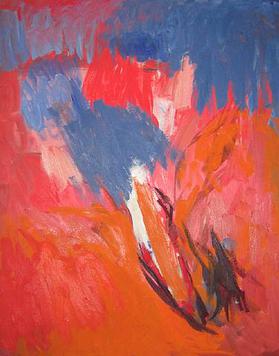Ethel Schwabacher facts for kids
Quick facts for kids
Ethel Schwabacher
|
|
|---|---|

Photo of American painter Ethel Schwabacher
|
|
| Born |
Ethel Kremer
May 20, 1903 |
| Died | November 25, 1984 (aged 81) |
| Nationality | American |
| Education | Art Students League of New York |
| Known for | Painting |
| Movement | Abstract Expressionism |
| Spouse(s) | Wolf Schwabacher |
Ethel Schwabacher was an American painter known for her unique style called Abstract Expressionism. She was born in New York City on May 20, 1903, and passed away there on November 25, 1984. Her paintings were shown in famous galleries like the Betty Parsons Gallery in the 1950s and 1960s.
Ethel was a close friend and student of another important artist, Arshile Gorky. She even wrote the first book about his life and work. She also knew many other famous New York painters, like Willem de Kooning and Richard Pousette-Dart. Besides painting, she also wrote a book about the artist John Ford and a book about her own life called "Hungry for Light".
Contents
Becoming an Artist
Ethel Schwabacher was born in New York in 1903. When she was five years old, her family moved to Pelham, where she started painting in her garden. She went to Horace Mann School. At just 15, she joined the Art Students League of New York to study art. She also studied sculpture at the National Academy of Design until 1921.
In 1927, Ethel decided to focus on painting. She joined Max Weber's painting class at the Art Students League. That same year, she met Arshile Gorky, and they became very good friends.
Developing Her Style
Ethel lived in Europe from 1928 to 1934. When she returned, she continued to study with Gorky between 1934 and 1936. Gorky taught her about automatism, a way of drawing or painting freely from your subconscious mind.
In the 1930s, Ethel began to explore her own inner thoughts and feelings. She combined automatism with abstract shapes, often inspired by nature. Her paintings frequently showed themes of womanhood, childbirth, and children.
Family Life and Later Years
In 1934, Ethel married Wolf Schwabacher, a well-known lawyer. They had two children: Brenda Webster, who became a critic and novelist, and Christopher Schwabacher, who became a lawyer. Her cousin, George Oppen, a poet who won the Pulitzer Prize, also lived in New York during the 1930s.
After her husband passed away, Ethel used her art to express her feelings. She created a series of paintings based on ancient Greek myths. She passed away on November 25, 1984.
Where to See Her Art
Ethel Schwabacher's artwork is part of many important art collections. You can find her paintings in places like The Metropolitan Museum of Art, the Whitney Museum of American Art, the Solomon R. Guggenheim Museum, and the Brooklyn Museum in New York City. Her work has also been shown in many galleries, including the Anita Shapolsky Gallery and the Betty Parsons Gallery.
Her art was featured in a special exhibition called "Women of Abstract Expressionism" at the Denver Art Museum in 2016. It was also shown at the Palm Springs Art Museum in 2017.
Exploring Themes in Her Work
Like other female abstract expressionist artists, Ethel Schwabacher's work often faced being seen only through her roles as a woman, wife, and mother. However, her art explored deeper ideas.
She used loose brushstrokes and bold colors to show themes important to the Abstract Expressionism movement. These included ideas from psychology, dream states, and the unconscious mind. Her use of Greek myths in her Odes series was not just about personal loss, but also connected to her interest in the Surrealism art movement.
See also


